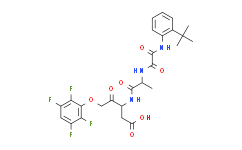| Cas No.: | 254750-02-2 |
| Chemical Name: | Emricasan |
| Synonyms: | (S)-3-((S)-2-(2-((2-(tert-Butyl)phenyl)amino)-2-oxoacetamido)propanamido)-4-oxo-5-(2,3,5,6-tetrafluorophenoxy)pentanoic acid;Emricasan;(S)-3-((S)-2-(2-((2-(tert-Butyl)phenyl)amino)-2-oxoacetamido)propanamido)-4-oxo-5-(2,3,5,6-tetrafluorophenoxy)pentanoic...;(S)-3-((S)-2-(2-(2-TERT-BUTYLPHENYLAMINO)-2-OXOACETAMIDO)PROPANAMIDO)-4-OXO-5-(2,3,5,6-TETRAFLUOROPHENOXY)PENTANOIC ACID;(S)-3-((S)-2-(2-(2-tertbutylphenylamino)-2-oxoacetamido)propanamido)-4-oxo-5-(2,3,5,6-tetrafluorophenoxy)pentanoic acid;CHEMBL197672;CS-0599;Emrian;UNII-P0GMS9N47Q;IDN-6556;N-[2-(1,1-dimethylethyl)phenyl]-2-oxoglycyl-N-[(1S)-1-(carboxymethyl)-2-oxo-3-(2,3,5,6-tetrafluorophenoxy)propyl]-L-Alaninamide;IDN 6556;N-[2-(tert-butyl)phenyl]-2-oxoglycyl-N-[(1S)-1-(carboxymethyl)-2-oxo-3-(2,3,5,6-tetrafluorophenoxy)propyl]-L-alaninamide;Emricasan(IDN6556,PF03491390);PF 03491390;P0GMS9N47Q;Emricasan [USAN:INN];Emricasan (USAN/INN);GTPL6508;C26H27F4N3O7;BCP07463;s7775;2073AB |
| SMILES: | FC1C(=C([H])C(=C(C=1OC([H])([H])C([C@]([H])(C([H])([H])C(=O)O[H])N([H])C([C@]([H])(C([H])([H])[H])N([H])C(C(N([H])C1=C([H])C([H])=C([H])C([H])=C1C(C([H])([H])[H])(C([H])([H])[H])C([H])([H])[H])=O)=O)=O)=O)F)F)F |
| Formula: | C26H27F4N3O7 |
| M.Wt: | 569.5021 |
| Sotrage: | 2 years -20°C Powder, 2 weeks 4°C in DMSO, 6 months -80°C in DMSO |
| Description: | Emricasan (PF 03491390) is an irreversible pan-caspase inhibitor. |
| In Vivo: | Emricasan (IDN-6556) is orally active that is retained in the liver for prolonged period of time. TUNEL-positive cells are considerably increased by five-fold in mice fed a HFD and are reduced under Emricasan treatment. In accordance with this observation caspase-3 and -8 are increased in HFD-fed mice by 1.5- and 1.3-fold respectively and are significantly decreased by Emricasan treatment[1].When comparing efficacy by multiple routes of administration, Emricasan is administered i.p., p.o., i.m., or i.v. (0.03-3 mg/kg). Caspase 3-like activities, measured as DEVD-AMC cleavage, dose dependently decreased with a 92.5% reduction after the highest dose of Emricasan (3 mg/kg). Emricasan is initially tested in the α-Fas model of liver injury, marked hepatocellular apoptosis, and peak ALT activities within 6 h. Emricasan is administered i.p. immediately after administration of α-Fas, ALT activities, measured 6 h later, decreased in a dose-dependent manner with an ED50 value of 0.08 (0.06-0.12) mg/kg[2]. Emricasan is a highly selective pan-caspase inhibitor demonstrating irreversible inhibition and a significant first-pass effect. In both syngeneic mouse islets and human islets transplanted into immunodeficient mice, Emricasan (i.p., 20 mg/kg) given for 7 days post-transplant led to a significantly enhanced rate of diabetes reversal as compared to vehicle[3]. |

 DC Chemicals' products qualify for U.S. tariff exemptions. We guarantee no price increases due to customs duties and maintain stable supply, continuing to deliver reliable research solutions to our American clients.
DC Chemicals' products qualify for U.S. tariff exemptions. We guarantee no price increases due to customs duties and maintain stable supply, continuing to deliver reliable research solutions to our American clients.





















